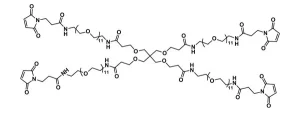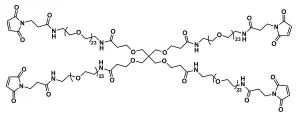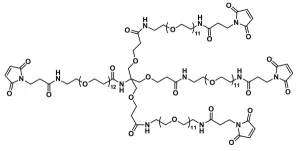Bromoacetamido-dPEG®12-Tris(-dPEG®11-amido-bromoacetamide)3, product number QBD-11434, is a branched, single molecular weight, thiol-reactive, discrete polyethylene glycol (dPEG®) product. It is designed to join up to four molecules via a thiol-bromoacetyl reaction. Each of the four arms attaches to a central tris core and terminates with a thiol-reactive bromoacetyl group. The dPEG® spacer length from between the bromoacetyl groups through the tris core is 87 atoms (100.0 Å).
Like the thiol-maleimide reaction, the thiol-bromoacetyl reaction forms stable thioether bonds with free thiols. However, maleimides react optimally at pH 6.5 – 7.5, while bromoacetyl groups react with thiols chemoselectively at pH ≥8.0. Moreover, thioether bonds formed from a thiol-maleimide reaction can sometimes undergo a reverse Michael addition, undoing the thioether bond. This does not happen with thioether bonds formed by a thiol-bromoacetyl reaction. The thiol-bromoacetyl reaction is chemoselective for thiols but slightly less selective than the thiol-maleimide reaction.
Unlike traditional polyethylene glycol (PEG), which are non-uniform, dispersed polymers, Vector Laboratories’ dPEG® products are single molecular weight PEGs with discrete chain lengths, hence the dPEG® name. The four arms of MAL-dPEG®12-Tris(-dPEG®11-amido-MAL)3 are built around a core of tris(hydroxymethyl)aminomethane (“”tris””). Although one arm is structured a little differently than the other three arms (one dPEG®12 arm vs. three dPEG®11 arms), the product is essentially symmetrical through the tris core. This precise construction of Bromoacetamido-dPEG®12-Tris(-dPEG®11-amido-bromoacetamide)3 is possible because of Vector Laboratories’ dPEG® technology. This product can link multiple peptides or proteins together for drug delivery. It could also be used as a core unit for constructing dendrimers with precisely defined spacer lengths.
| Unit Size | 100 mg, 1000 mg |
|---|---|
| Molecular Weight | 3000.75; single compound |
| Chemical formula | C₁₂₀H₂₃₀Br₄N₈O₅₆ |
| CAS | N/A |
| Purity | > 97% |
| Spacers | dPEG® Spacer is 87 atoms and 100.0 Å |
| Shipping | Ambient |
| Typical solubility properties (for additional information contact Customer Support) | Methylene Chloride, Methanol, Acetonitrile, DMF, or DMSO. |
| Storage and handling | -20°C; Always let come to room temperature before opening; be careful to limit exposure to moisture and restore under an inert atmosphere; stock solutions can be prepared with dry solvent and kept for several days (freeze when not in use). dPEG® pegylation compounds are generally hygroscopic and should be treated as such. This will be less noticeable with liquids, but the solids will become tacky and difficult to manipulate, if care is not taken to minimize air exposure. |
Greg T. Hermanson, Bioconjugate Techniques, 2nd Edition, Elsevier Inc., Burlington, MA 01803, April, 2008 (ISBN-13: 978-0-12-370501-3; ISBN-10: 0-12-370501-0). Specifically see pp. 726-729 in his Chapter 18 on discrete PEG compounds for pegylation applications.
Greg T. Hermanson, Bioconjugate Techniques, 3rd Edition, Elsevier, Waltham, MA 02451, 2013, ISBN 978-0-12-382239-0; See chapter 18, Discrete PEG Reagents, pp.787-821, for a full overview of the dPEG® products.
Applicable patents and legal notices are available at legal notices.



Stay in the Loop. Join Our Online Community
Products
Ordering
About Us
Application
Resources

©Vector Laboratories, Inc. 2025 All Rights Reserved.
To provide the best experiences, we use technologies like cookies to store and/or access device information. Consenting to these technologies will allow us to process data such as browsing behavior or unique IDs on this site. Not consenting or withdrawing consent, may adversely affect certain features and functions. Privacy Statement
How do I Request a Quote?
To request a quote for products: